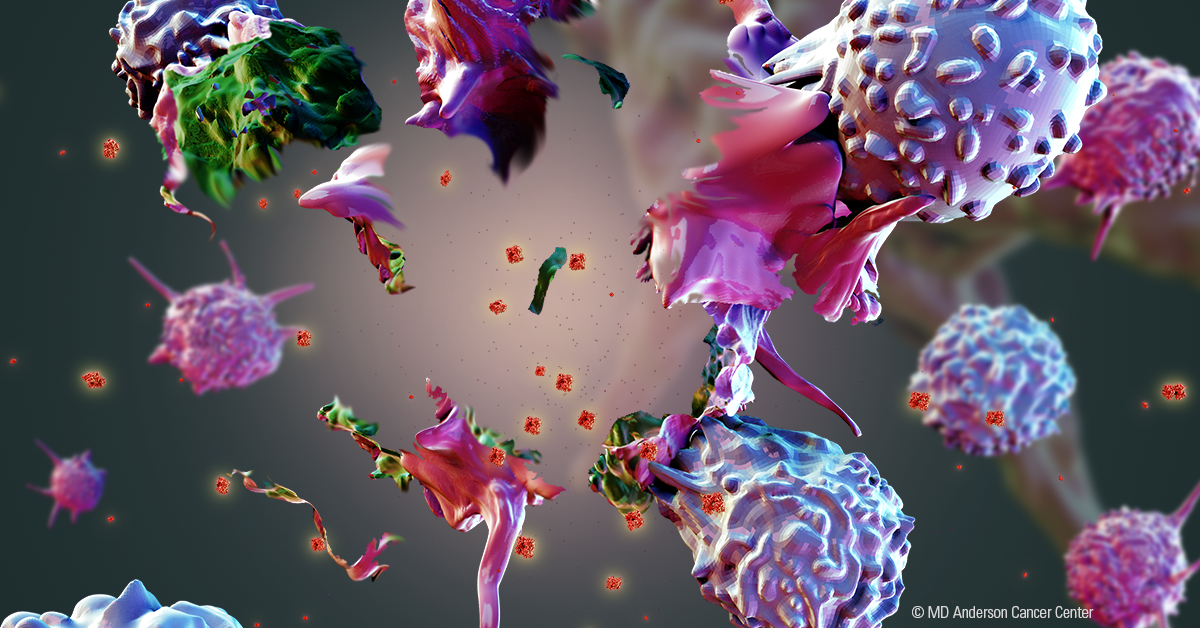- Diseases
- Acoustic Neuroma (16)
- Adrenal Gland Tumor (24)
- Anal Cancer (70)
- Anemia (2)
- Appendix Cancer (18)
- Bile Duct Cancer (26)
- Bladder Cancer (74)
- Brain Metastases (28)
- Brain Tumor (234)
- Breast Cancer (726)
- Breast Implant-Associated Anaplastic Large Cell Lymphoma (2)
- Cancer of Unknown Primary (4)
- Carcinoid Tumor (8)
- Cervical Cancer (164)
- Colon Cancer (168)
- Colorectal Cancer (118)
- Endocrine Tumor (4)
- Esophageal Cancer (44)
- Eye Cancer (36)
- Fallopian Tube Cancer (8)
- Germ Cell Tumor (4)
- Gestational Trophoblastic Disease (2)
- Head and Neck Cancer (14)
- Kidney Cancer (130)
- Leukemia (342)
- Liver Cancer (50)
- Lung Cancer (286)
- Lymphoma (278)
- Mesothelioma (14)
- Metastasis (30)
- Multiple Myeloma (100)
- Myelodysplastic Syndrome (60)
- Myeloproliferative Neoplasm (6)
- Neuroendocrine Tumors (16)
- Oral Cancer (102)
- Ovarian Cancer (178)
- Pancreatic Cancer (160)
- Parathyroid Disease (2)
- Penile Cancer (14)
- Pituitary Tumor (6)
- Prostate Cancer (150)
- Rectal Cancer (58)
- Renal Medullary Carcinoma (6)
- Salivary Gland Cancer (14)
- Sarcoma (238)
- Skin Cancer (300)
- Skull Base Tumors (56)
- Spinal Tumor (12)
- Stomach Cancer (66)
- Testicular Cancer (28)
- Throat Cancer (92)
- Thymoma (6)
- Thyroid Cancer (100)
- Tonsil Cancer (30)
- Uterine Cancer (86)
- Vaginal Cancer (18)
- Vulvar Cancer (22)
- Cancer Topic
- Adolescent and Young Adult Cancer Issues (22)
- Advance Care Planning (12)
- Biostatistics (2)
- Blood Donation (18)
- Bone Health (8)
- COVID-19 (360)
- Cancer Recurrence (120)
- Childhood Cancer Issues (120)
- Clinical Trials (628)
- Complementary Integrative Medicine (22)
- Cytogenetics (2)
- DNA Methylation (4)
- Diagnosis (238)
- Epigenetics (6)
- Fertility (62)
- Follow-up Guidelines (2)
- Health Disparities (14)
- Hereditary Cancer Syndromes (128)
- Immunology (18)
- Li-Fraumeni Syndrome (8)
- Mental Health (122)
- Molecular Diagnostics (8)
- Pain Management (62)
- Palliative Care (8)
- Pathology (10)
- Physical Therapy (18)
- Pregnancy (18)
- Prevention (936)
- Research (390)
- Second Opinion (78)
- Sexuality (16)
- Side Effects (616)
- Sleep Disorders (10)
- Stem Cell Transplantation Cellular Therapy (216)
- Support (408)
- Survivorship (328)
- Symptoms (182)
- Treatment (1788)
Epigenetic protein plays key role in lung cancer and melanoma development
5 minute read | Published October 21, 2020
Medically Reviewed | Last reviewed by an MD Anderson Cancer Center medical professional on October 21, 2020
Layered on top of our genes is an additional set of information -- the epigenome, which is important for many cellular activities. Disruption of the epigenome is a major hallmark of cancer development. MD Anderson researcher Kunal Rai, Ph.D., is focused on better understanding the epigenome’s role in cancer.
Rai’s team has recently published studies in Cancer Cell and Cell Reports that report a key role for the epigenetic regulator, KMT2D, in the development of lung cancer and melanoma. These two studies also identified an attractive therapeutic target for patients with KMT2D mutations, which occur in about 15% of all cancers.
Rai spoke with us about the epigenome, its role in cancer development, and the findings of his work.
What is the epigenome?
I should start by explaining the genome, which is a concrete set of information laid out in a particular sequence of A, T, C and G bases. Those sequences make up our genome and genes, which code for proteins in our cells to do a variety of functions.
‘Epi’ means over – thus, the epigenome is a set of instructions laid over the genome. These instructions come in the form of chemical modifications made directly to the DNA bases or instead to histone proteins, around which the DNA is wrapped. The histones are an important structural element in our cells that help to condense and organize our DNA into various domains. Together, DNA and histones constitute nucleosomes, the basic unit of the epigenome.
The epigenetic modifications are reversible, which allows for a dynamic set of instructions that can change over time as cells grow, mature and differentiate. The epigenome can also be inherited from one generation to the next.
What is the role of the epigenome?
The major function of the epigenome is to regulate our gene expression, which is the process of converting genes into protein. A good analogy for the epigenome’s role is like that of a light switch with a dimmer. It can help to turn genes expression on or off completely as well as up or down slightly, as needed.
At a high level, the chemical modifications to DNA or histones serve as a platform for the binding of additional regulatory proteins. These proteins ultimately dictate if a gene will be expressed and, if so, to what extent.
This epigenome is regulated through a complex process of reading and writing the chemical modifications and subsequent remodeling of the nucleosomes. There are three main players involved in this process – proteins that add the chemical modifications, proteins that remove the modifications and proteins that read and rearrange the nucleosome structure.
What is the connection between the epigenome and cancer?
For several decades, we have known that there is an interplay between the epigenome and cancer. In the 1980s, the first epigenetic modification of DNA methylation was discovered to be dramatically altered in cancer cells relative to normal cells. As the field has evolved and we have discovered more types of these modifications and epigenetic elements, we continue to see that the epigenome is drastically changed in cancer.
In the last decade, cancer genomic studies have discovered mutations in proteins that regulate the epigenome so there is disruption in how the cell can add or remove the modifications or remodel the chromatin structure. Laboratory studies have shown us that these mutations help the cancer cells to survive by allowing expression of other cancer-driving genes and processes.
The fact that we so often see changes to the epigenome in cancer or mutations in epigenetic regulators has revealed that disruption of the epigenome is a key hallmark of cancer development.
Can you target the epigenome to treat cancer?
There are a few therapies against the epigenetic modifier proteins that have been approved for treating cancers. For example, azacitidine is a drug that blocks methylation of the DNA, one type of epigenetic modification. It is routinely used to delay or block the progression of myelodysplastic syndrome to acute myeloid leukemia.
Another class of drugs is histone deacetylase inhibitors, which block the removal of certain modifications. These have been approved for treating several types of lymphoma. A third class of epigenetic inhibitors block the reader proteins of histone modifications, such as bromo-domain inhibitors that have been actively investigated in clinical studies in the last few years. A number of other drugs have been developed for epigenetic modifiers.
Scientists are beginning to explore these drugs in combination with immunotherapy, such as immune checkpoint inhibitors. These combinations appear to be effective in laboratory studies and now are being tested in clinical trials.
However, we still have not seen as much success with these therapies in solid tumors. My research has focused on trying to better understand epigenetic regulation so we can identify treatment targets in solid tumors.
What did your recent studies reveal?
Our recent work has focused on a protein called KMT2D, which is a major writer of epigenetic modifications to the histone proteins. It contributes modifications to gene enhancers, which help to fine-tune the expression of certain genes.
In the studies that we published this year in Cancer Cell and Cell Reports, we found that the loss of KMT2D not only leads to changes in the epigenome, but also promotes the growth of lung cancer and melanoma by increasing glycolysis, a key metabolic pathway to serve the increased energy needs for the cell. That is a key component to how KMT2D might drive cancer progression.
How can these findings benefit patients in the future?
We discovered that these lung cancer and melanoma cells with KMT2D mutations are reliant on glycolysis, providing us with a therapeutic target. We showed in our studies that these lung cancer or melanoma cells are sensitive to treatment with glycolysis inhibitors. The melanoma cells could also be treated with a drug targeting an insulin-signaling pathway.
Based on these studies’ findings, this could be a personalized treatment approach for patients with KMT2D mutations. We hope to move into clinical trials to evaluate this as a therapeutic strategy. There is also some evidence of immune dysregulation from KMT2D mutations, so we would like to explore whether immune checkpoint inhibitors could be useful here as well.
Request an appointment at MD Anderson online or by calling 1-877-632-6789.
Related Cancerwise Stories

The fact that we so often see changes to the epigenome in cancer or mutations in epigenetic regulators has revealed that disruption of the epigenome is a key hallmark of cancer development.
Kunal Rai, Ph.D.
Researcher





